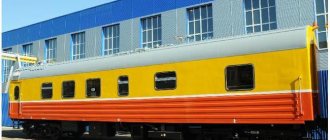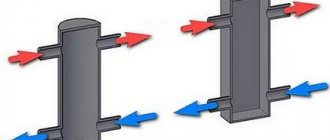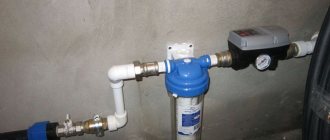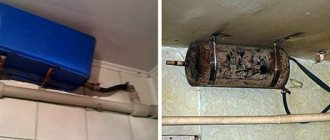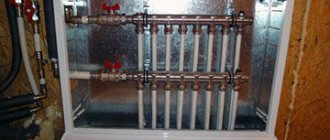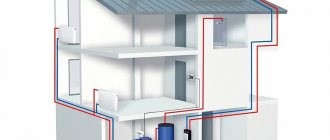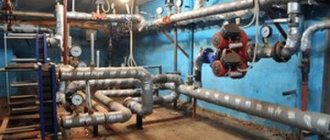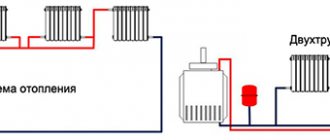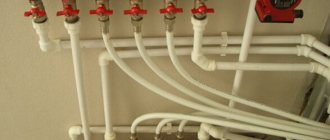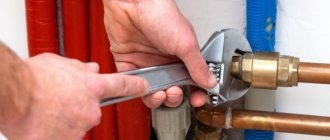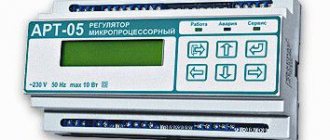The principle of operation of the collector and how to choose it
The collector, or “comb”, as it is often called popularly, has at its base two main pipes (supply and return), to which nozzles are connected. Each such pipe has a continuation of the supply or return pipeline, respectively. A pump is installed on the supply manifold to circulate hot water.
A servo drive is mounted on the supply manifold to close the valve. When the water temperature reaches the specified parameters, the temperature sensor, when triggered, activates the servo drive, which presses the valve. The valve, in turn, blocks further water supply until the next moment it is cooled by a certain number of degrees.
After the heat is transferred through the radiator into the room, the water in the reverse circle of the system returns to the boiler, where it is heated again and supplied to the collector for further circulation.
Maintaining the required water pressure on the supply manifold is achieved by installing special regulators. They also regulate the required amount of water.
The choice of the required collector is influenced by the following factors:
- area of premises;
- number of radiators;
Collector design and operating principle
A collector heating system is a comb from which leads come out for connecting heating devices. The number of such conclusions can be completely different. If necessary, the unit can be supplemented with bends. You can also install valves for draining and releasing water and air, and heat meters on the collector.
Adjustment or shut-off valves can also be installed on the terminals, thanks to which it will be possible to regulate or turn off the flow of the coolant. The device is installed in the heating system as a collector block, which includes a supply and return comb. They are equipped with release valves and taps.
Components of the collector unit
The heating comb functions very simply. The coolant, which is heated by the boiler to the required temperature, goes into the supply comb. It is then distributed among heating appliances. A pipeline is made to each device, through which the coolant flows. In the radiator, the liquid, which has already given up some of the heat, is partially cooled, goes through another pipe to the return comb and from there to the boiler. Thanks to this distribution, the radiators heat up evenly, since each has a separate supply pipe.
In a multi-storey building, a heating manifold is installed on each floor, which makes it possible to obtain separate floor-by-floor heating circuits with autonomous regulation.
If necessary, you can turn off the heating of the entire floor or just a few devices, so maintaining and repairing the heating mixing unit is much easier. This distribution will not affect the operation of the entire heating system in any way. The use of a collector system increases the operating efficiency of heating equipment, since devices that regulate the temperature and pressure of the coolant and a flow meter can be installed on its outputs.
Heating plan with collectors
Pipe selection
The main point of installing collector wiring is the correct choice of pipes. In the installation of this system, a large number of connections are used, which entails the use of a large number of clamps and fittings. For this purpose, soft, flexible suture metal-plastic or polyethylene pipes are most suitable. Copper pipes are used to exit the pipes from the manifold.
These pipes have the properties of preventing air from entering due to a special coating on the outer surface.
The most optimal pipe diameter is 16 mm. However, you should consult a specialist on this issue.
Advantages and disadvantages of the collector system
Due to the emergence of a variety of plastic and polyethylene pipes, the collector heating system has replaced the tee system, due to the following advantages:
- When installing and operating a collector heating system, you can do without highly qualified specialists.
- The efficiency factor (efficiency) increases due to the fact that the coolant delivers heat to the radiators faster and with less losses . This is achieved due to the operation of the circulation pump and the poor thermal conductivity of plastic pipes. These pipes carry heat with the least loss to the radiators, which, thanks to their special design, effectively heat the room.
- Increasing the efficiency of the heating system makes it possible to reduce pipe diameters and boiler power, and also saves fuel.
- Since plastic pipes from heating devices to collectors do not have connectors (joints), they can be walled up in the floors and walls of the house . This gives an aesthetic appearance to the room.
- Makes it possible to heat a house without traditional radiators using heated floors.
- High maintainability. Since it is possible to disconnect any section of the pipeline from the water supply, without interfering with the functionality of the entire heating system.
- Simplicity of design , since there is no need to apply complex mathematical calculations.
- Possibility of adjusting the temperature on each heating device. What creates a certain comfort
The disadvantages of a collector heating system are:
- Airing the system . The air remains in the system after it is filled with coolant, which enters the heating devices horizontally and quickly under the influence of the pump. Air from microscopic bubbles combines and accumulates at the highest points of the radiators.
- High cost due to the presence of a pump, manifolds, shut-off valves and a large number of pipes for moving the coolant.
- Cannot work without circulation pump .
- A special room is required for the manifold cabinet.
- Labor-intensive installation and material consumption.
The nuances of the procedure for de-airing heating radiators are described in this article: https://teplo.guru/sistemy/udalenie-vozduha-i-vozdushnoy-probki.html
From the above it is clear that the collector heating system is considered reliable and comfortable for a low-rise cottage. But the cost of this system is much higher than the tee system .
Advantages and disadvantages of a distribution manifold for a heating system
The collector version of the heating system has its positive and negative sides. Such a comb is capable of ensuring uniform heat distribution and maintaining the required coolant temperature in all heating devices. At the same time, it is possible to organize a decrease in temperature if necessary.
By adjusting the heating manifold, you can not only control the temperature, but also completely cut off any branch, which helps prevent idle heat transfer. This is especially convenient for a large house where some rooms are not used for living. The system is adjusted from the heating manifold cabinet.
The distribution manifold unit is characterized by ease of installation and repair. If one of the system parts breaks down, it will be enough to cut off the damaged branch using a control device. The heating comb has an attractive appearance, which allows you to place the device in any convenient place.
Installing a heating collector is the most effective and reliable option for a private home
The disadvantages of the hydraulic collector include the high cost of the design, which is associated with the high cost of the material from which the product is made. High-quality fittings are also quite expensive. However, the cost of installation work is kept to a minimum, which is due to the simplicity of the design.
The heating system will operate fully and efficiently only in conjunction with a circulation pump, the operation of which will entail additional energy costs.
The comb design involves a large number of branches for each heating device, for which a separate pipe is installed. This increases the complexity of installation and the total cost of the entire system.
In what cases is a collector heating system acceptable?
There is no standard solution when drawing up a diagram of a collector system, and there are also no generally accepted planning standards. The selection of equipment should be carried out by specialists, taking into account the specific tasks that need to be solved.
The opinion of experts should not be ignored: such a system cannot be recommended for heating in multi-storey buildings.
Heating system options in multi-storey buildings
The problem is that heating in the apartment is provided by the supply of coolant to at least two risers. A prerequisite for the system under consideration is the connection of all radiators to one riser.
Having left one source of heat, you will need to shut off the others, i.e. brew them. The entire load will be concentrated on the left riser, and a closed hydraulic circuit will be formed within a particular apartment.
All radiators located on the upper floors will be cut off from the centralized heating system and no coolant will flow into them. Naturally, residents of the upper floors will express dissatisfaction and will demand the forced restoration of the previous communications.
The only legal option for using collector circuits in an apartment building would be when additional valves were installed during the construction process, allowing the connection of circuits of different configurations.
Selecting pipes for a heating system for a residential building or apartment
When creating a manifold wiring diagram for heating a low-rise residential building or other private building, it is necessary to take into account the method of laying pipes throughout the house. If the piping will run under the floor, in a concrete screed, then it is recommended to buy heating pipes in coils so as not to make connections in the floor, as mentioned above.
Plastic pipes must have sufficient flexibility, the pipe material must not be subject to corrosion and the influence of aggressive environments, must not be destroyed at low or too high temperatures, and the service life of the pipes must be extremely high.
The requirements for temperature resistance and tensile strength of pipes are determined by the performance characteristics of the installed heating system in a house or apartment. For individual development, the pressure in the pipes should not exceed 1.5 atm, and the maximum temperature regime should be in the range of 500C -750C. If the house has a “warm floor” system, then the temperature of the coolant in the pipes should not rise above 300C -400C.
Manifold for combined heating
When installing a manifold heating circuit in an apartment building, the pressure in the pipes will always be high, and the pipe material must withstand ≥ 10-15 atm. at a coolant temperature of up to 110-1200C. Therefore, when laying heating pipes in an apartment building, it is recommended to use corrugated pipes made of stainless steel, rather than metal-plastic or PVC products. As a working example, we can cite the Kofulso brand of pipes, which can withstand pressures of more than 15 atm. at coolant temperature ≥ 1100C. The pressure force that causes the destruction of this material is 215 kgf/cm², which is an excellent indicator.
Collector wiring in the apartment
The bending radius of such stainless pipes is equal to their diameter, which allows them to be laid in almost any place and with any bend, without fear that the pipe will leak at the bend. Connections in such piping are made using special fittings, and the twist points are fixed with a lock nut, which ensures the tightness of the connection of corrugated pipes with silicone seals.
But stainless steel is not the cheapest material, and when installing manifold pipes in a two- or three-story building, such a project will be quite expensive. Therefore, it makes sense to use pipes made of cross-linked polyethylene, for example, PE-X brand. These pipes, like other PVC products, are sold in coils, the length of one pipe is 200 meters, the material is able to withstand pressure up to 10 kgf/cm² at a coolant temperature in the system up to 950C. A short-term increase in temperature up to 1100C is allowed.
Corrugated stainless steel pipes
Water pipes made of cross-linked polyethylene are also connected to each other using special fittings in the form of plastic or metal (bronze, brass, copper) fittings with a locking ring, which fits tightly onto the pipe and seals it tightly. The advantage of such pipes is that cross-linked polyethylene has a mechanical memory, that is, assembly is carried out according to the following scheme: the pipe is stretched with a special extender so that a fitting can be inserted, and after some time (up to a minute) the pipe takes on the original diameter and tightly presses the fitting. Additionally, tightness is ensured by a locking ring.
The feasibility of installing a collector system
Recently, collector heating systems have also begun to be used in the construction of multi-storey apartment buildings using wall-mounted boilers.
But it is impossible to install a collector heating system in an apartment of old multi-storey buildings, because a tee heating system is already working there. For the collector system to operate, it is necessary to close the hydraulic circuit, which is necessary to create coolant circulation in the system. If a closed hydraulic circuit is created in one apartment, then other apartments will be cut off from the heating system .
The collector heating system also cannot be used in areas with unstable power supply, since when the circulation pump stops, the water will freeze and the pipes will fail. But the situation can be somewhat improved by using non-freezing liquid for the heating system.
Features of the collector system
If the distribution comb of the heating system is installed in a low-rise country house or private house, then here it is considered the most efficient and reliable. The installation of such a system will be more expensive than the installation of traditional one- and two-pipe systems.
DIY heating distribution manifold
When you plan to install collector heating, you should remember that it will not be able to work without a circulation pump.
In addition, installation of such a system is quite labor-intensive and complex. Undoubtedly, it is best to entrust the installation of a collector system to professionals. For installation you will need a lot of pipes, since there will be individual wiring from the collector to each heating device.
Types of collectors in heating systems
Collector installations used in the design of closed circulation heating systems come in three varieties.
Depending on the purpose of the design, the following are available on the market: radiator and solar systems, as well as devices equipped with a hydraulic arrow.
Type #1 - radiator collector heating
Whatever type of heating is designed in the house, radiators are always present in it. Therefore, collectors that distribute coolant flows directly to batteries installed in rooms are the most popular type.
The distribution unit consists of two interconnected combs: the first directs the coolant to the appliances installed in the rooms, the second takes it back to the boiler
Collectors used for radiator heating, depending on the architectural and interior features of the room, can be connected in various ways.
According to the connection method, the radiator heating system can be made in any of the following versions:
- top connection;
- bottom connection;
- side installation;
- leading diagonally.
Specifics of distributor operation
Collector design
The collector is a distribution-type device for a heating system, which promotes uniform heat distribution. The cooled water flows back into the boiler under the influence of circulation. The main branches attached to the distributor function independently.
Device design
The intermediate node consists of two parts. The supply comb supplies the coolant to the communications, and the return comb leads it to the heat generator when it cools. Two combs are a collector group, and each of them can connect one circuit or several connections to heating devices. The pressure inside each circuit is adjustable.
Features of work
The principle of operation of collector heating is to heat the water with a heat generator and send it to the supply comb. Due to the large internal diameter of the unit, the liquid contained in it slows down the speed and is distributed over all outlets.
The coolant moves to the individual circuit through connecting pipes with a smaller diameter than the distributor. Heated water can be directed to radiators and underfloor heating systems, ensuring uniform heating of each element.
After entering the circuit and releasing heat, the water moves through another pipeline to the distributor. The direction will be the opposite. Having reached the return comb, the coolant is sent to the heat generator.
The collector type of heating is suitable if you have a country house or a two-story cottage.
Modifications of distributor combs
Today, there are many types of collectors for heating systems on the equipment market.
Manufacturers offer both connecting links of the simplest design, the design of which does not provide for the presence of auxiliary fittings for regulating the equipment, and manifold blocks with a full set of built-in elements.
A collector block that includes all the necessary functional elements to create conditions for uninterrupted and high-performance operation of the heating system
The simple-to-use devices are brass models with one-inch branches, equipped with two connecting holes on the sides.
On the return collector, such devices have plugs, instead of which, in the case of “expanding” the system, additional devices can always be installed.
Intermediate assemblies that are more complex in design are equipped with ball valves. For each outlet they provide for the installation of shut-off control valves. Sophisticated, expensive models can be equipped with:
- flow meters , the main purpose of which is to regulate the flow of coolant in each loop;
- temperature sensors designed to monitor the temperature of each heating device;
- automatic air release valves
- electronic valves and mixers aimed at maintaining the programmed temperature.
The number of circuits, depending on the connected consumers, can vary from 2 to 10 pieces.
Regardless of the complexity and versatility of the equipment, materials that are resistant to external factors are used in the manufacture of manifold block combs
If we take the manufacturing material as a basis, then intermediate prefabricated collectors are:
- Brass - characterized by high performance parameters at an affordable price.
- Stainless steel structures are extremely durable. They can withstand high pressure with ease.
- Polypropylene - models made of polymer materials, although they have a low price, are inferior in all characteristics to their metal “brothers”.
Models made of metal are treated with anti-corrosion compounds and covered with thermal insulation to extend their service life and improve performance parameters.
Separating structures made of polymers are used in the construction of systems heated by boilers with a power of 13 to 35 kW
Parts of the device can be cast or equipped with collet clamps, allowing connection to metal-plastic pipes.
But experts do not advise choosing combs with collet clamps, since they often “sin” by leaking coolant at the valve connection points. This occurs due to rapid failure of the seal. And it is not always possible to replace it.
Collectors are used in single- and two-pipe heating schemes. In single-pipe systems, one comb supplies the heated coolant and receives the cooled one
Purpose
A warm floor is usually a system that includes several heating circuits - at least one for each room. With a large floor area or to control heating separately in different zones of the same room, two or more circuits are used.
Heating comb, distribution manifold - names of the device that ensures the flow of coolant into the circuits of the floor heating system. The distribution unit consists of two combs - one of them is responsible for distributing the coolant heated by the boiler over the connected heating circuits, the second collects the cooled coolant and supplies it to the return pipe for return to the boiler.
Mounted distribution unitSource ad-cd.net
In addition to the main function of distributing and collecting coolant, the collector unit can solve a number of other problems. Depending on the configuration, it can:
- be responsible for deaerating the system;
- ensure regulation of the coolant supply in the required volumes;
- regulate the flow of circulating fluid using manual or automatic flow meters.
This allows you to maintain optimal temperature conditions in each room, depending on the requirements for the microclimate, and eliminate airing of the heating system, which results in a decrease in the efficiency of its operation. Shut-off valves are also installed on the supply and return manifolds - through them the circuits are filled with coolant, the system is pressure tested, and the liquid is drained.
Manifold group with automatic air ventsSource tvo.by
Manifold wiring for heated floors
Installation of a heated floor using collector wiring is carried out similarly to a conventional water floor. You can install a heat transfer element under the floor covering and then connect it to the collector. Practice shows: it is possible to combine a collector for floor heating together with heating through radiators, but this should not be done. Multi-temperature systems.
It is worth remembering about thermal regulation: heated floors have less heat transfer, radiators have more.
The collector heating system today is the most efficient, economical, and quickly pays for itself. It is convenient, simple, and visually invisible, which makes living where it is installed as comfortable as possible.
Selection of system components
When designing heating, it is best to purchase factory-made distribution units.
Thanks to the diversity of the range, it will not be difficult to select a comb for certain heating parameters, thereby ensuring the accuracy and reliability of the system.
On sale you can find ready-made manifold blocks that combine supply and return units, as well as thermostatic valves and automatic air vents
The key parameters when choosing pipes for heating circuits are corrosion resistance, heat resistance and high burst strength. In addition, the pipes must have the necessary flexibility so that they can be laid at any angle.
When choosing products, preference should be given to pipes produced in coils. The use of one-piece products will allow you to avoid connections in the wiring, which is especially important for closed installation methods inside the screed.
Pipes for private cottage systems
When designing heating in private houses, it is worth focusing on the fact that the pressure in the system is about 1.5 atmospheres, and the coolant temperature can reach:
- for radiators – 50-70 degrees;
- for heated floors – 30-40 degrees.
For autonomous heating systems with their predictable parameters, it is not at all necessary to purchase stainless corrugated pipes. Many owners limit themselves to purchasing pipes made of cross-linked polyethylene marked “PEX”.
Polyethylene pipes for heating circuits are available for sale in 200-meter coils; they are able to withstand pressure up to 10 kgf/kV.cm and operate at temperatures within 95 °C
Such pipes are joined using tension fittings, so that inextricable connections can be obtained.
In addition to high performance parameters, the main advantage of cross-linked polyethylene is the mechanical memory of the material. Therefore, if you forcefully stretch the edge of the pipe and insert a fitting into the resulting gap, it will tightly surround it, ensuring a strong connection.
When using metal-plastic pipes, the connection is made using union fittings with crimp nuts. And this already turns out to be a detachable connection, which, according to SNiP, cannot be “solidified”.
You may also find information about which pipes are best to choose for heating, discussed here.
Pipes for apartment buildings
If the collector system is installed in an apartment building, then it is worth considering that the operating pressure in it is 10-15 atmospheres, and the coolant temperature can reach about 100-120 °C. It should be remembered that collector heating is only possible on the ground floor.
The best option for installing the system in an apartment building is the use of corrugated pipes made of stainless steel.
A clear example of this is the products of the Korean company Kofulso. Pipes of this brand are capable of operating at a working pressure of 15 atmospheres and withstand temperatures of about 110 °C. The collapse pressure of Kofulso pipes reaches 210 kgf/sq.cm.
Due to the excellent flexibility of the pipe, in which the bending radius is equal to its diameter, the products are convenient to use when laying “warm floors”
Assembling pipeline connections using such elements is not difficult. The pipe is simply inserted into the fitting and secured by screwing on a nut, which compresses the corrugated metal surface with an elastic silicone seal.
Popular manufacturers of heating system manifolds
Popular manufacturers of high-quality collectors are the companies Rehau and Oventrop, which provide the maximum warranty period for their products. Consumers note the high quality of products, reliability, ease of installation and long service life.
Oventrop specializes in the production of universal manifold models that are ideal for radial heating, underfloor heating and water supply systems. High-quality stainless steel is used to manufacture products. The collectors can withstand temperatures up to 120 °C. The cost of products varies from 2.5 to 28 thousand rubles.
The most popular among consumers are radial heating combs made of stainless steel. Such collectors are designed for a pressure of 10 bar and a system temperature of up to 100 °C. You can buy the product for 1.7 thousand rubles. Distribution manifolds for underfloor heating made of tool steel are produced with valve accessories, with the help of which the operation of the system is regulated. The manifolds are designed for pressures of 6 bar and temperatures up to 70 °C. You can buy a double-circuit product for 3.5 thousand rubles.
Rehau distribution manifolds have a more attractive appearance, which makes it possible to mount them on the wall in an open manner. Products are made of stainless steel and brass. The company produces improved models equipped with flow meters, taps, valves and a pump. You can purchase the device for 1.5-32 thousand rubles, which depends on the number of circuits of the product.
Rehau distribution manifolds are not only very reliable, but also have an attractive appearance
The HKV comb for underfloor heating systems, made of brass, is very popular. The manifold is designed for temperatures up to 80 °C and operating pressure up to 6 bar. The cost of a double-circuit product is 6.5 thousand rubles.
The Rehau HLV distribution manifold can be used for radial heating. The brass product can withstand temperatures of 80 °C and pressure of 8 bar. The price of the model is 4 thousand rubles.
The domestic manufacturer North deserves attention, offering high-quality hydraulic manifolds at an affordable price, which varies between 2.5-20 thousand rubles. Products are made primarily of steel. Pexay heating collectors are characterized by an ideal price-quality ratio, the price of which averages 5-12 thousand rubles.
System installation features
The collector heating system of a private house should be installed during the construction stage. After all, after laying or pouring the finished floor, installing such a system will become economically infeasible. The only solution to the problem in this case will be an open method of wiring installation.
Installation of distribution comb
On the floors of houses with horizontal heating distribution, to accommodate the collector, circulation pump and control equipment, you will need to install a closed box - a collector cabinet.
A closed box will protect equipment and shut-off valves from external mechanical influence and give the room a more aesthetic appearance
The manifold cabinet is installed in separate niches of rooms protected from moisture. Most often, a place is allocated for this in the hallway, dressing room or pantry.
When designing the heating of a two-story building, it will be necessary to install two collector groups: on the first and second levels. Additional distribution units will ensure approximately the same length of the circuit.
As an option, you can take as a basis a scheme in which the first group will be responsible for the distribution of heat along individual circuits, and the second will act as a key component in arranging a “warm” floor.
The heated coolant from the room with the boiler flows through the main lines to the collectors installed floor-by-floor
The number of collector inputs and outputs is always equal to the number of heating elements located on the floor: radiators or underfloor heating rings. For each room, a separate branch is laid, which, by combining several heating devices, will implement a passing or dead-end circuit.
To reduce the cost of connecting radiators, a “pass-through” circuit is used.
In a “pass-through” scheme, the thermal valve is installed only on the first circuit of the radiator; due to which the water flow is regulated on all devices connected in series behind it
With a “pass-through” system, several devices connected in series will be perceived as one element.
Pipeline laying options
When collecting pipes, the most commonly used method is laying pipes in a concrete screed. Its thickness varies between 50-80 mm, which is quite enough to “monolithize” the intra-house wiring of the heating system.
But according to SNiP, only unbreakable connections are allowed to be laid in concrete.
Any radiator or convector is connected to the collector through two pipes: “supply” and “return”, so the pipes are laid in the floor screed in pairs
For this purpose, metal-plastic pipes with a diameter of 16 mm are often used. Due to the fact that they bend easily, it is convenient to lay the pipeline under the floor.
When planning to fill metal-plastic pipes with concrete screed after pressure testing of the system, it is necessary to first wrap them with thermal insulation.
Such a layer will minimize the risk of pipe damage due to thermal expansion, since in this case they will “rub” not against the concrete, but against the insulation.
When laying pipes in a screed, connections in accordance with the requirements of SNiP must be left accessible, placing them above the floor level for this purpose
Plywood is laid on top of the screed, which is covered with a finishing floor covering: linoleum or parquet.
Pipes can also be connected to radiators from the side or from above, for example: in the space of a false ceiling.
Some craftsmen prefer to lay pipes externally, placing them along the walls and hiding them behind decorative skirting boards. But this method of installation entails an inevitable increase in the length of the pipeline.
It is not recommended to lay the pipeline through doorways. This can lead to the fact that when installing the threshold of an interior door, the pipe will be damaged at the time of drilling.
If the pipeline needs to be laid through a wall, in order to prevent its damage due to shrinkage of the building, the hole in the wall should be equipped with a sleeve.
A separate shut-off valve is installed on each hydraulic circuit coming from the distribution comb.
To be able to bleed the air accumulated in the system, install:
- on the distribution unit - air release valves;
- on radiators (accumulates at the highest points) - Mayevsky taps.
Disadvantages and advantages of the collector circuit
The complexity of piping when implementing a collector circuit is compensated by its advantages:
- Each radiator is an autonomous and separately controlled element. That is, in each room you can set the desired temperature regardless of the temperature in the boiler or in other heating circuits, or turn off the radiator (group of radiators) without stopping the heating system;
- Taking into account the fact that each heat pipe connected to the manifold from the heating system transports hot liquid to only one heating device, it is more advisable to use pipes of reduced diameter compared to the calculated total diameter of the pipes. In this case, it is recommended to maintain the minimum permissible distance between the heating device or group of radiators and the collector.
Separate connection of heating devices
A home-made or factory-made collector heating system, the diagram of which for general cases is given above, is valued by consumers due to the possibility of creating several independent heating circuits with different temperatures and pressures. This scheme allows you to organize different temperature conditions for different rooms in the same building with one boiler. To connect several circuits, another version of the collector is equipped - a hydraulic arrow, which outwardly looks like a large water pipe.
The hydraulic arrow is installed differently from the manifold - the circulation cycle is closed between the coolant supply pipe and the return pipe. The boiler continues to continuously heat the liquid in the primary circuit, and the coolant in the hydraulic arrow begins to move, allowing it to be cut into to connect radiators at different points and at different levels.
Due to this unusual connection of radiators to the hydraulic arrow, at the end point of a single heat sink (radiator) there will be different temperature and pressure indicators. Turning on the hydraulic arrow is advisable when combining the distribution of heating pipes using radiators and a “warm floor” system.
Homemade hydraulic gun
At the places where the circuits are connected, the pressure and temperature in the pipes will be different, but if the do-it-yourself collector heating of a private house, the diagrams and drawings of which were developed for circulation pumps, will use them, then this difference in drops does not matter. Also, heating circuits can be connected in series (no more than two in a circuit), but with this arrangement of connecting the circuits it will be impossible to regulate separately from each other.
Series connection of collectors
The disadvantages of the collector organization of piping should be noted as follows:
- The energy consumption of the collector circuit is higher than when batteries are connected in series. Moreover, the larger the heated area, the higher the heat costs;
- Manifold heating equipment is designed to operate only in a one- or two-pipe heating system design, which can be routed along the walls of the premises. But when organizing radial distribution, it will not be possible to lay pipes along the walls or in a hidden way due to the large volume of the practical circuit and the large number of heating pipes;
- When laying pipes in the floor under a concrete screed, the following disadvantages of the method appear: for pipes laid under the floor, it is not allowed to make any connections - neither welded, nor threaded, nor any other, in order to prevent hidden leakage, otherwise the layer will have to be removed concrete screed, and this is almost a major renovation of the premises with all the ensuing consequences;
- The total hydraulic resistance of the collector heating circuit will be significant, especially when laying pipes with a small diameter. Also, when implementing a collector pipe routing scheme, it is necessary to use a circulation pump (pumps), since the natural pressure in the pipes will not allow the coolant to move freely through the pipes;
- When using several autonomous heating circuits in a collector heating circuit, each large circuit must have its own circulation pump installed. This leads to financial costs both during installation of the system and during its operation;
- The energy dependence of the collector heating system is one of its significant disadvantages, since circulation pumps require connection to the electrical network. In the event of an emergency power outage, the heating will not be able to provide the required thermal conditions, since the movement of the coolant through the pipeline will simply stop.
Distributor for radiant heating system
Let us remind you: radial wiring provides for an individual two-pipe connection of each radiator to a common distribution manifold located in a convenient location (usually closer to the center of the building).
An example of radiant heating distribution in a one-story house
To install the collector unit, the following combs are used:
- factory for TP (described above), made of stainless steel, brass or plastic;
- factory for water supply with built-in shut-off valves, made of polypropylene or metal;
- homemade manifolds twisted from brass fittings and polypropylene tees.
The type of comb you choose depends on your budget and radiator system requirements. If each battery is equipped with its own balancing valve and thermal head, then a clean manifold without valves and flow meters is sufficient. Leave the air and water discharge module.
Advice. If you have a limited budget, you can choose an inexpensive water supply manifold with taps, shown in the photo. Many homeowners do this and balance the system with radiator valves.
If you want to automate the heating operation and place all adjustments in a manifold cabinet, buy a comb for underfloor heating. Install all accessories - rotameters, valves with servo drives, air vents, room regulators. A mixer is still not needed; the coolant is supplied to the batteries directly from the boiler room.
The video below shows a combined heating manifold that distributes heat to radiator wiring and floor circuits. Both parts of the comb are installed in parallel. Please note that the master used water distributors to distribute the coolant.
Installation nuances
The technology for attaching the collector to the wall is quite simple: the TC and radial distribution comb are suspended on mounting brackets, the loops are connected with Eurocone fittings. Pipes going to the top of the collector (usually the “return”) are passed under the bottom.
Advice. No one is forcing you to mount the distributor on brackets. If necessary, the tubes can be spread apart and mounted separately on the wall. The collector box is used in residential areas; when installing the collector in the boiler room, the cabinet is not needed.
Let's briefly list the main points:
- The size of the comb is selected according to the diameter of the pipes used in the heating loops - Ø16 or Ø20 mm. Accordingly, we take a ¾ or 1 inch distributor. The material of the product does not matter; in terms of price/quality ratio, stainless steel wins.
- If the number of comb outlets exceeds 12, assemble a collector assembly of 2 sections. When installing accessories, winding materials are not used, since the parts are equipped with rubber seals.
- A heavier common house collector is suspended on hooks, reinforced brackets, or installed on the floor. Pumps, pipes and other piping elements must not load the distributor with their own weight.
- The hottest coolant receives an indirect heating boiler. The coil and circulation pump of the water heater are connected to the comb directly, usually from the end.
- The radiator heating and TP branches are connected to the manifold through mixing units with three-way valves. A separate pump is installed on each line, selected for pressure and performance.
A heavy coplanar comb can be installed on the floor - weld metal supports
Important point. The mixing unit for heated floors can be installed in the boiler room, near the main comb. Then water at the required temperature will flow to the TP distributor.
Main manufacturers
Some people pay little attention to this aspect. Confident that the design is simple, they do not think about the fact that over time, water supply collectors fail. Each of them will need repair or replacement. The only question is how soon this will happen, and how often problems will arise. Now there are several “whales” on the plumbing market:
- Far (Italy).
Despite the fact that the products of this company can be classified as a budget segment, the quality is very acceptable. The products are reliable, easy to use, unpretentious, and durable.
- Rehau (Germany).
The price of this product is higher, but the consistent German quality allows you to use the products of this company for a long time. The brass from which the structural elements are made can withstand aggressive environments, does not rust or rot.
- Tiemme (Italy).
The products belong to the middle price segment, which has made them popular among professionals, developers, and contractors. Low cost combined with reliability are the main characteristics of collectors of this brand.
- Luxor (Italian).
The main advantage is the use of innovative technologies in production. Each product is tested for functionality before leaving the assembly line. Material: brass.
- UNI-FITT (Italian).
The company produces a full range of components with which you can install a supply or heating system. The range is constantly expanding, and now there are more than 1000 items.
It's easy to get confused about manufacturers and models. To make the right choice, there are a number of recommendations that guide professionals.
Finally about homemade collectors
Above in the text we mentioned budget options for combs - tap, polypropylene and homemade. Such distributors can be used without problems in radiator beam circuits. To balance and regulate the flow, a balance valve and a faucet with a thermal head are installed on each battery. The collector is equipped with “air vents” + drain taps.
If you put the indicated combs on the TP, you will encounter the following nuances:
- the distributor cannot be equipped with rotameters;
- without flow meters it is difficult to balance circuits of different lengths;
- Factory plastic manifolds have shut-off valves, which means there is nothing to regulate the flow;
- combs assembled from polypropylene or brass tees have many joints;
- It's worth noting that homemade distributors don't look too good.
A self-made underfloor heating manifold can still be brought to perfection. We assemble the distributor from tees, and on the return connections we mount thermostatic radiator valves with RTL-type thermal heads, as shown in the photo.
